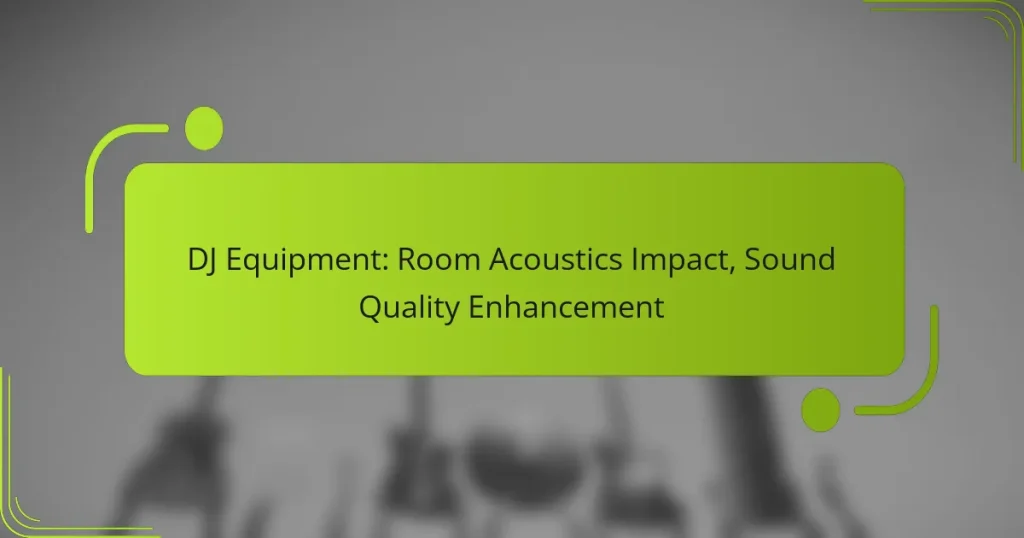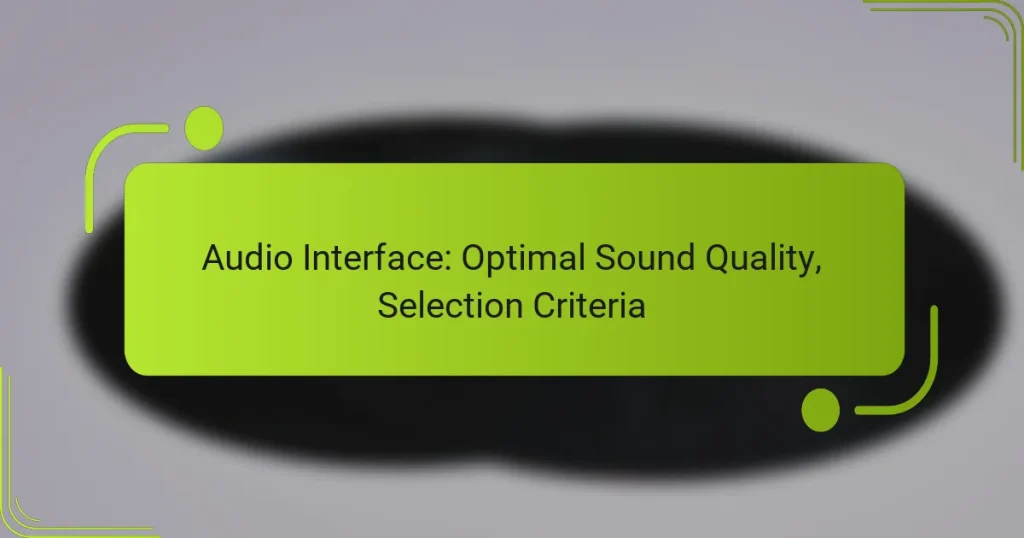When it comes to DJ equipment, sound quality is paramount for delivering an exceptional auditory experience. High-end mixers and controllers are essential, as they ensure clear audio with minimal distortion. By evaluating key technical aspects such as frequency response and dynamic range, DJs can make informed decisions about the gear that best suits their sound quality requirements.
DJ Controllers: Superior Sound Quality, Top Rated Options
DJ Mixers: Sound Quality Comparison, Budget-Friendly Options
Audio Interface: Optimal Sound Quality, Selection Criteria
DJ Headphones: Sound Isolation, Noisy Environment Performance
DJ Equipment: Sound Quality Evaluation, Small Venue Suitability
DJ Speakers: Frequency Response, Professional Use Considerations
What are the best DJ equipment options for sound quality?
The best DJ equipment for sound quality typically includes high-end mixers and controllers that deliver clear audio and low distortion. Key factors to consider are the quality of the components, signal processing capabilities, and user reviews focusing on sound performance.
Pioneer DJ DJM-V10
The Pioneer DJ DJM-V10 is renowned for its exceptional sound quality, featuring a 6-channel mixer that allows for versatile audio routing. Its high-resolution audio processing ensures clarity and depth, making it suitable for both live performances and studio use.
With built-in effects and a customizable EQ, DJs can tailor their sound to fit various genres. The robust build quality and professional-grade components make it a top choice for serious DJs.
Denon DJ X1850 Prime
The Denon DJ X1850 Prime offers a powerful sound engine with 24-bit/96kHz audio quality, ensuring pristine sound reproduction. Its 4-channel mixer design allows for seamless integration of multiple audio sources, enhancing performance flexibility.
Additionally, the X1850 features advanced effects and a user-friendly interface, making it easy to manipulate sound in real-time. DJs appreciate its low latency and high headroom, which contribute to a clean audio output.
Rane Seventy-Two MKII
The Rane Seventy-Two MKII is a battle mixer that excels in sound quality, featuring dual USB ports for easy connectivity and seamless switching between DJs. Its 24-bit audio processing delivers rich, detailed sound, making it ideal for competitive environments.
With customizable effects and a responsive touchscreen, this mixer allows for creative sound manipulation. The durable construction ensures reliability during intense performances, making it a favorite among professional DJs.
Allen & Heath Xone:96
The Allen & Heath Xone:96 is known for its analog warmth and clarity, featuring a 6-channel mixer with high-quality filters and effects. Its dual USB sound cards enable easy integration with digital setups, providing flexibility for various performance styles.
This mixer’s robust build and intuitive layout make it a reliable choice for both club and festival settings. DJs often praise its ability to maintain sound integrity even at high volumes.
Native Instruments Traktor Kontrol S4 MK3
The Native Instruments Traktor Kontrol S4 MK3 combines advanced sound quality with a user-friendly interface, featuring high-resolution audio output. Its integration with Traktor Pro 3 software allows for extensive sound manipulation and effects processing.
This controller is designed for both beginners and professionals, offering features like haptic feedback jog wheels for precise control. The S4 MK3’s compact design and portability make it a practical choice for DJs on the go.
How to evaluate sound quality in DJ equipment?
Evaluating sound quality in DJ equipment involves assessing various technical aspects that influence audio performance. Key factors include frequency response, dynamic range, and signal-to-noise ratio, each contributing to the overall listening experience.
Frequency response analysis
Frequency response analysis measures how accurately a DJ system reproduces different frequencies. A flat frequency response is ideal, ensuring that all sounds, from bass to treble, are represented equally without coloration.
When evaluating, look for a frequency response range that typically spans from 20 Hz to 20 kHz, which covers the full spectrum of human hearing. Deviations in this range can signal potential issues, such as a lack of bass or overly harsh highs.
Dynamic range measurement
Dynamic range measurement refers to the difference between the quietest and loudest sounds a DJ system can produce without distortion. A wider dynamic range allows for more expressive performances, capturing subtle nuances in music.
For DJ equipment, a dynamic range of at least 90 dB is desirable. This ensures that both soft and loud passages can be played back clearly. Pay attention to specifications and listen for compression artifacts during testing.
Signal-to-noise ratio
The signal-to-noise ratio (SNR) indicates the level of desired audio signal compared to background noise. A higher SNR means cleaner sound with less interference, which is crucial in live settings where clarity is essential.
A minimum SNR of 90 dB is recommended for DJ gear to ensure that noise does not detract from the music. When testing, listen for hiss or hum, especially at lower volumes, as these can indicate a poor SNR.
What features enhance sound quality in DJ gear?
Several key features significantly enhance sound quality in DJ equipment, including high-quality digital-to-analog converters (DACs), the choice between analog and digital mixers, and built-in effects processors. Understanding these elements can help DJs select gear that meets their sound quality needs.
High-quality DACs
High-quality digital-to-analog converters (DACs) are crucial for converting digital audio signals into analog signals without losing fidelity. A good DAC can minimize distortion and noise, resulting in clearer sound reproduction. When choosing DJ gear, look for devices with DACs that support higher bit rates and sample rates, typically 24-bit/96kHz or better.
For instance, many professional DJ mixers come equipped with premium DACs that enhance audio clarity, making them suitable for live performances. Investing in gear with superior DACs can lead to a noticeable improvement in overall sound quality.
Analog vs digital mixers
The choice between analog and digital mixers can significantly impact sound quality. Analog mixers often provide a warmer, more natural sound, while digital mixers offer advanced features like effects processing and precise control over audio signals. DJs should consider their style and the type of events they perform at when making this choice.
Analog mixers are typically easier to use for beginners and can deliver a richer sound, but digital mixers allow for greater versatility and customization. If sound quality is the primary concern, testing both types in a live setting can help determine which suits your needs best.
Built-in effects processors
Built-in effects processors can enhance sound quality by adding depth and character to audio signals. These processors allow DJs to apply various effects, such as reverb, delay, and compression, directly to their mixes. High-quality effects can create a more engaging listening experience and can be crucial for live performances.
When selecting DJ gear, consider mixers with high-quality effects processors that offer a range of customizable options. Avoid low-cost models that may introduce unwanted artifacts or degrade sound quality. A well-designed effects processor can elevate your performance and make your mixes stand out.
What are the top-rated DJ headphones for sound quality?
The top-rated DJ headphones for sound quality include models that deliver clear audio, strong bass, and excellent noise isolation. These headphones are essential for DJs who need to monitor tracks accurately in loud environments.
Sony MDR-7506
The Sony MDR-7506 is a classic choice among DJs, known for its exceptional sound clarity and comfort. With a frequency response of 10 Hz to 20 kHz, these headphones provide a balanced sound profile that highlights both low and high frequencies.
They are lightweight and foldable, making them easy to transport. The closed-back design ensures effective noise isolation, allowing DJs to focus on their mixes without external distractions.
Sennheiser HD 25
The Sennheiser HD 25 headphones are favored for their durability and high sound pressure levels, making them ideal for live performances. They feature a frequency response of 16 Hz to 22 kHz, delivering a punchy bass and crisp highs.
These headphones are also designed for comfort during long sessions, with a lightweight build and a secure fit. Their single-ear monitoring capability allows DJs to listen to the crowd while mixing, enhancing the overall performance experience.
Audeze LCD-X
The Audeze LCD-X headphones stand out for their planar magnetic drivers, which provide an expansive soundstage and detailed audio reproduction. With a frequency range of 5 Hz to 20 kHz, they excel in delivering deep bass and clear mids.
While they are on the pricier side, their build quality and sound performance make them a worthwhile investment for professional DJs. The open-back design offers a more natural listening experience, but may not be suitable for noisy environments.
What is the impact of speaker placement on sound quality?
Speaker placement significantly affects sound quality by influencing how sound waves interact with the room and the listener. Proper positioning can enhance clarity, balance, and overall audio experience, while poor placement may lead to muddiness or uneven sound distribution.
Optimal positioning techniques
To achieve optimal sound quality, speakers should be positioned at ear level when seated and angled towards the listening area. A common guideline is to place speakers at least a few feet away from walls to reduce reflections that can muddy the sound. A triangle formation, where the speakers and listener form the points, is often recommended for balanced sound.
Consider using a measuring tape to ensure that the distance between the speakers and the listener is roughly equal to the distance between the speakers themselves. This setup can help create a more immersive listening experience.
Room acoustics considerations
Room acoustics play a crucial role in sound quality. Hard surfaces, such as tile or glass, can cause sound reflections that lead to echoes, while soft furnishings can absorb sound and reduce clarity. It’s beneficial to assess your room’s materials and layout to identify potential acoustic challenges.
Using acoustic panels or bass traps can help mitigate undesirable reflections and enhance sound quality. Additionally, experimenting with speaker placement in different locations within the room can reveal the best setup for achieving clear and balanced audio.
How do different audio interfaces affect sound quality?
Different audio interfaces can significantly impact sound quality by influencing factors such as latency, dynamic range, and signal clarity. The choice of interface affects how audio is converted from analog to digital and vice versa, which is crucial for achieving high-fidelity sound.
Latency considerations
Latency refers to the delay between input and output in an audio system. A lower latency is essential for live performances and recording, as it allows for real-time monitoring without noticeable delays. Look for interfaces that offer latency in the low milliseconds range for optimal performance.
Dynamic range and bit depth
The dynamic range of an audio interface indicates the difference between the quietest and loudest sounds it can capture. Interfaces with higher bit depth, such as 24-bit, provide a greater dynamic range, allowing for more detailed sound reproduction. This is particularly important for genres that rely on subtle nuances, like classical or jazz.
Signal clarity and noise floor
Signal clarity is crucial for high-quality audio, and it can be affected by the noise floor of the audio interface. A lower noise floor means less background noise, resulting in clearer recordings. When selecting an interface, aim for one with a noise floor below -100 dB for professional-grade sound quality.






